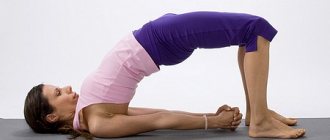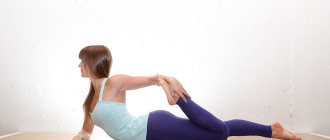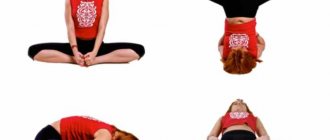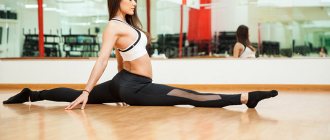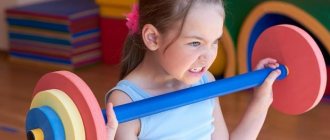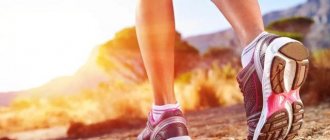Child's pose in yoga: how to do the exercise?
First stage
- Stand on a yoga mat.
- Close your legs and knees together and sit on your heels.
- Exhaling, bend your body forward.
- Press your chest to your knees and touch your forehead to the floor.
Hands can be positioned in two ways:
- stretch it forward and place it in front of you, palms down;
- place along the body with palms up, while lowering your shoulders.
Second phase
Press your upper body firmly against your thighs. Try to reach your heels with your pelvic area. At the final stage of the asana, you need to completely relax.
The arms, neck and shoulders should fall down under the weight of their own weight.
Third stage
Maintain the position for 5-6 breathing cycles.
Exit from the asana should be slow, without sudden movements. Inhale and move your hands along your thighs, turning your palms down. Lean on them and smoothly lift your body.
The meaning of the Downward Facing Dog pose
If you look at a yogi standing in a downward-facing dog pose, you will notice that he really does look a little like this animal, which has relaxed and is stretching its muscles with pleasure. Experienced masters, when performing an asana, completely retreat into their inner world. However, beginners will initially have to concentrate as much as possible to maintain balance. The necessary skills will definitely appear, but for this the exercise must be practiced regularly.
Reference! “Adho Mukha Svanasana” is the name of the pose in Sanskrit. Translated, “svanasana” means dog, and “adho mukha” means face down.
Possible contraindications
It is not recommended to perform Balasana if you have an upset stomach. If the knee joint is damaged, place a pillow under the leg area. In order not to provoke a surge in blood pressure during hypertension, use a yoga block on which you can lean your head.
In order not to harm their health, pregnant girls should practice the asana under the supervision of an instructor.
Pregnant women should pay attention to the happy child pose in yoga. It is technically simpler, relieves nausea and stretches the thigh muscles.
What to pay attention to
First of all, this is, of course, breathing - it should be calm, deep enough and not tense. You can even imagine how energy (prana) penetrates your body with each inhalation, and how with each exhalation your back and shoulders relax. In general, visualization is a working thing, for example, in qigong it is used with might and main, and it bears fruit.
Relaxation is the key aspect of this pose. In the final position you need to relax as much as possible. Ideally, don’t even cling to the stream of thoughts, but simply be an outside observer. In order to achieve good relaxation, combine it with breathing, or rather, imagine how with each exhalation your body becomes more and more relaxed, as if it is filled with warmth and “spreads.”
Features when performing
Virasana pose can be used as a starting position before Balasana.
For a stronger stretch, reach your arms forward, lifting your buttocks away from your heels. Squeeze your shoulder blades together and lower them toward your lower back. Without changing your position, slowly lower your pelvis onto your heels.
Beginners can perform the exercise in a simplified form:
- use a blanket. Place it on your calves if you feel discomfort sitting on your heels.
- To keep your buttocks in contact with your heels, spread your knees wider. Lower your body between your thighs. The heels should be connected together, and the pelvis should rest on the heels.
Benefit
Balasana is considered one of the most common asanas in relaxation practice. The pose is very calming and also relieves feelings of stress and fatigue. During headaches, you can put something soft under your head. It also helps improve digestion, reduce volume in the waist and hips, and increase overall tone.
The practice of Balasana has a relaxing effect on the muscles of the thighs, buttocks and ankles. While performing the asana, the flow of blood in the knee joints becomes difficult, but after straightening the legs, a powerful restoration of blood circulation occurs. This process activates metabolism and rejuvenates the legs.
Balasana is often classified as a meditation pose because it helps to “turn” the attention inward.
Legendary meditation course without payment We recommend! The most popular meditation course for beginners in Russian.
More than 100 thousand people have already learned to meditate. Try it yourself. Read more. Reference! Conduct an experiment, stay in Balasana for 10 minutes, and when you return to the starting position, observe how the sensations of sound and color have transformed.
Sleep Techniques
Abdominal Breathing (Vashisht Pranayama)
The technique is aimed at increasing the flow of oxygen to tissues, which leads to the regeneration of body cells, eliminates excessive stress and promotes quality sleep.
Execution sequence:
- Relax and lie on your back.
- Bend your knees, feet touching the floor.
- Place your arms along your body so that the distance between your hips and arms is a few centimeters. Palms face up.
- Concentrate on your breathing.
- Inhale slowly through your stomach and hold your breath.
- Exhale slowly, while the stomach returns to its original state.
Repeat the cycle 15-20 times.
Asana Viparita Karani with raised legs
The restorative pose aims to relax the body and mind, and it also neutralizes the effects of daytime stress.
This is one of the most accessible passive positions that does not require flexibility or strength. In addition, regular practice of the technique contributes to:
- eliminating muscle spasms;
- relief of attacks of headache and lumbar pain;
- normalization of blood pressure and heart rate;
- overcoming anxiety.
However, the asana has contraindications: glaucoma, hernia, menstruation in women.
Execution sequence:
- Start by creating a cozy space near the wall. Place a mat on the floor or sit directly in bed.
- Lie on your back. Press your hips into the wall. If desired, the head is placed on a pillow, hands on the stomach or along the body. The position should be as relaxed as possible.
- Raise your legs vertically until your body is in an L shape. Try not to tilt your torso at a 90-degree angle, as this will impede blood circulation in your legs. Instead, move your hips a few inches away from the wall and place a pillow under your pelvis.
- Take a deep, long breath through your nose, then exhale the same way, or use pranayama.
To achieve results, stay in the pose for at least 10-15 minutes.
Useful tips for children and parents
Buy your own yoga mat for your practice. The child's clothes should not hinder his movements or rub him, so it is better to use natural materials. Feet usually remain bare during exercise.
To ensure your child’s safety during training, it is important to consider some details of children’s practice:
- Children under 14 years of age should not remain in an upside-down position for long periods of time.
- Snacks are allowed 3 hours before class, no later.
- While performing asanas (postures), you cannot stand on your head, since the child’s spine is not yet adapted to such loads.
- You should not practice yoga during a cold, especially if the disease is accompanied by difficulty breathing.
- The ideal time to exercise is in the morning, but you can also exercise during the day, at least 3 hours before bedtime.
- A few minutes before the start, the baby should clear the nasal passages, empty the intestines and bladder.
For children, it is recommended to choose groups with a playful form of exercise. Make sure that classes are conducted in a well-ventilated area, otherwise the child’s well-being may worsen.
It is important that the instructor immediately explains how to breathe through the nose correctly without retaining oxygen in the lungs.
Tilt from a sitting position
Upavistha Konasana
Bent over from a seated position with legs wide apart may seem simple, but it is not. Watch how your leg muscles work as you do this deep stretch.
- Sit on the mat and stretch your legs.
- Spread your legs as wide as you can. Make sure they remain straight and your toes and kneecaps point up.
- As you inhale, extend both arms up toward the ceiling. Straighten your back as much as you can.
- As you exhale, slowly lean forward. Bend your elbows and place them on the floor. They may lie directly in front of your hips, but if you have a good stretch, you can reach them in front of you.
- Stretch your head forward.
- Hold the pose for several inhalations and exhalations.
It doesn’t matter how wide you manage to spread your legs - 90 or 180 degrees. This stretching will be very useful in any case. Listen to your body and spread your legs far enough to feel the muscles stretch. There shouldn't be any pain!
30-day at-home yoga program for beginners
Yoga has been very popular lately, but it can be difficult to grab a mat and start doing poses in class together. The 30-day home training program is designed to give a start to your studies and reinforce the correct order of performing poses, which are arranged in order of difficulty. Once you start doing yoga, over time you will feel all the benefits of the classes and will no longer be able to quit, this will be the first month of your new life as a yogi. Some useful tips:
- You should spend about 15 minutes doing daily stretching and 30-45 minutes for an extended workout.
- Feel free to add new poses to your daily routine as you have the time to do so.
- You can take a group class instead of a long home workout if you prefer.
- Don't worry if you miss a day in your program, just pick up where you left off.
Yoga classes do not require a lot of additional equipment, but there are a few things that it is advisable to purchase in advance. First of all, this is a mat, but to start practicing at home, it is also advisable to have blocks, a belt and a comfortable blanket. Sun salutations will form the basis of your longer exercises. This may be strange at first, but over time, performing this complex will become more natural. Day one:
- Start your session with stretching.
- Add three cycles of sun salutations.
- Rest for a few minutes in the dead man's pose.
Week 1
During the first week of classes, stretch every day and do Sun Salutations every other day. Combine standing and sitting poses during your workouts for a longer session at least three times a week. Remember to rest in Repose Pose at the end of each session. Think about what time works best for you to practice. A good opportunity to do yoga in the morning, you can start the day with stretching, find the best time. Procedure for the first week:
- Day 1: stretching + 3 times Sun Salutation complex.
- Day 2: stretching + 3 times Sun Salutation complex + stretching in a sitting position.
- Day 3: Stretching.
- Day 4: stretching + 3 times Sun Salutation complex + stretching in a standing position.
- Day 5: Stretching.
- Day 6: stretching + 3 times Sun Salutation complex + stretching in a sitting position.
- Day 7: Stretching.
For the remainder of the month, you will perform short stretches daily and add variations to longer sequences of poses.
Week 2
- Day 1: Stretching.
- Day 2: stretching + 3 times Moon Salutation complex + sitting stretching + standing stretching.
- Day 3: Stretching.
- Day 4: stretching + 3 times Moon Salutation complex + standing stretches + balance poses.
- Day 5: Stretching.
- Day 6: stretching + 3 times Moon Salutation complex + standing stretching + yoga for the abs.
- Day 7: Stretching.
Week 3
- Day 1: Stretching.
- Day 2: stretching + 3 times Surya Namaskar + sitting stretching + standing stretching.
- Day 3: Stretching.
- Day 4: stretching + Surya Namaskar + standing stretching + balance poses + sitting stretching.
- Day 5: Stretching.
- Day 6: stretching + 3 times Surya Namaskar + standing stretching + yoga for the abs.
- Day 7: Stretching.
Week 4
- Day 1: Stretching.
- Day 2: stretching + 3 times Surya Namaskar + sitting stretching + standing stretching + arm yoga.
- Day 3: Stretching.
- Day 4: stretching + Surya Namaskar + standing stretching + balance poses + sitting stretching.
- Day 5: Stretching.
- Day 6: stretching + 3 times Surya Namaskar + standing stretching + abdominal yoga + sitting stretching.
- Day 7: Stretching.
By completing this 30-day routine, you will acquire the habit of practicing yoga every day. Continue to stretch daily and do longer stretches three times a week. This routine will allow you to get into the workout routine, develop an exercise habit, and will improve your fitness and tone in the long run.
Some tips to prepare yourself for yoga classes in the classroom or at home.
Not recommended:
- eat heavily before class (try eating lightly a few hours before the start of class);
- drink water during class, drink enough fluids before and after class;
- wear shoes or socks during class.
Recommended:
- at the first lesson, inform the instructor about your level in yoga;
- contact the instructor for help if necessary;
- come back for the next session of your yoga class.
What to do if it is difficult to perform the downward-facing dog pose
It can be difficult for beginner yoga practitioners to immediately get into the downward-facing dog asana. You cannot forcefully stretch your muscles to avoid damaging them. Therefore, there are several ways to make the exercise easier, including:
- Place your hands on the chair. He is placed against the wall to prevent him from moving. Place your palms on the seat, arching your lower back and pulling your pelvis back. As the body becomes trained, the need to use a chair disappears.
- Knee bending. This will help relieve tension in the leg muscles.
- Rising on tiptoes. This modification makes it possible to avoid overstraining the Achilles tendons and hamstrings.
- The position of the hands is narrower than shoulder width. This will make the pose more accessible to people without proper preparation.
Masters recommend that beginning yoga practitioners perform not 5, but 2 breathing cycles. You can then alternate between downward-facing dog and child's pose.
7–8 months: features of child development. Oblique (lateral) sitting
By 8 months, the child’s range of motion increases significantly, he begins to crawl throughout the apartment and learns to lift his body. The world around him captures all his attention! For this reason, it is often difficult for a child to fall asleep calmly and relaxed. You can organize the transition to sleep in a way that is fun for both you and your child. This can be done easily with a daily ritual. This could be calm caresses and hugs, storytelling (“What did we experience today?”), songs, or even a music box with a favorite melody. All these techniques can be used from early childhood. By constantly following the ritual, it will be easier for your child to prepare for bed. It is not necessary that both parents perform the same ritual, they must stick to their own ritual.
Important!
If the child has not rolled over from back to stomach by 8 months, then he needs therapy. Read more about diagnosing developmental disorders in children here.
